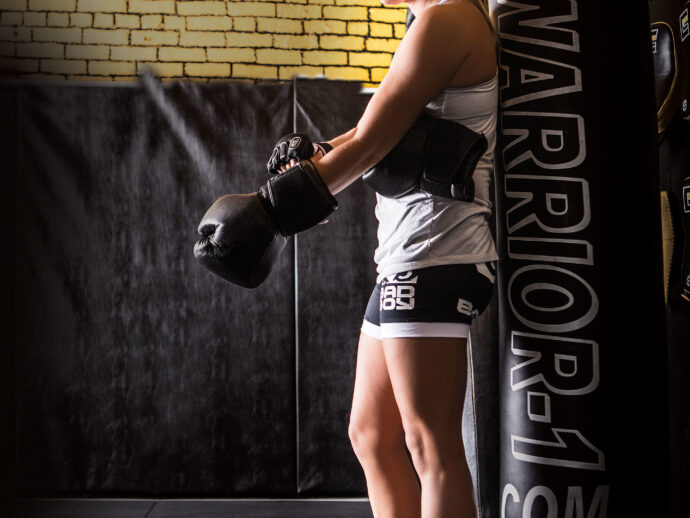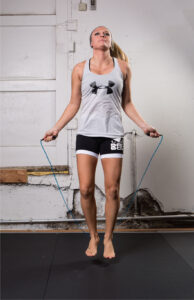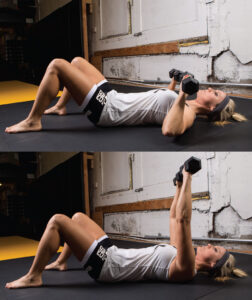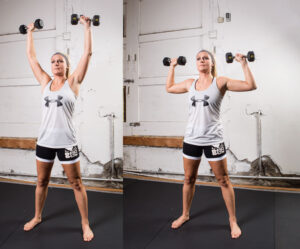
Tough. Bloody. Masculine. If this is your perception of boxing, think again.
A growing number of fitness enthusiasts, including Victoria’s Secret models like Gigi Hadid and Romee Strijd, are embracing boxing as a workout that burns calories, boosts agility and builds knockout muscles. Even if you’re not up for classes, an at-home boxing workout is doable for almost anyone.
What are the benefits?
Like many, Kathleen Sharpe had a negative opinion of boxing. “It always seemed like such a male sport, one that can be brutal,” recalls Sharpe, the director of a nonprofit organization.
A new friendship with a female boxer—and seeing a boxing class that looked fun, yet tough—led Sharpe into the sport. She boxes once a week as part of her workout regimen and credits the sport for helping her build muscle and sustaining a 30-pound weight loss for 10 years.
“For me, boxing is all about aging well, staying strong and looking great,” says Sharpe.
You’ll get a whole-body workout.
Teddy Castela, owner and coach at a boxing and fitness gym, witnesses boxing’s impact on weight loss and muscle tone on a regular basis: one of his clients lost 40 pounds through fight preparation, thanks to the 350 to 450 calories boxing torches in a single workout. This whole-body workout also sustains a heart rate at 75 to 85 percent of maximum.
“Everybody associates boxing with hands, arms and upper body, but the punches come from the legs and the rotation—there’s a big core element to it,” explains Castela.
You’ll be quicker on your feet.
In the ring, boxers bob and weave out of their opponent’s reach. These intricate evasion tactics require balance and agility. To advance these skills, coaches use exercises including balance boards, agility ladders, skipping and footwork drills.
You’ll be more coordinated.
Boxers must also become adept at hitting a moving target, so coaches like Castela help boxers develop their hand-eye coordination, primarily through mitt work (a small target held by a partner used to practice punching combinations, mimicking the action in the ring).
“Once you get sparring, it’s very similar to hitting the mitts,” says Castela.
You’ll feel more connected.
At Clancy’s Boxing Academy, managing director Kristina Ejem has seen boxers connect over the shared experience of learning a new sport.
Bonding also happens in the ring. “You’re bonded with these people for life because no one else can understand getting punched in the face every other day,” says Ejem.
Where to start?
Start with classes at a fitness club.
Some trainers, like Lee Milne, who teaches at Anytime Fitness, focus on developing boxing technique. Others use boxing-inspired moves in cardio workouts that will have you punching, kicking and blocking your way to a serious calorie burn.
Ejem adds that, whether or not you’re learning technique, boxing is one of the quickest ways to get in shape. “It feels great to throw punches and use your body in a different way,” says Ejem.
Level up to a boxing club.
While many clubs offer beginners’ and Boxfit classes, many also hold recreational workouts similar to a competitive boxer’s routine, with an emphasis on technique, and the option to spar.
Castela says the boxing club clientele are drawn to the competitive atmosphere of clubs where amateur and pro boxers train. Boxing clubs can also provide inspiration for recreational boxers.
“You can see [the fighters] pushing themselves to that limit and see it’s possible,” says Castela.
Women are also establishing a presence—at Ejem’s club, the membership is 60 to 70 percent female.
Graduate to sparring.
Once you’re comfortable with the classes at a boxing club, you might want to try your hand at sparring. Applying the skills and strategies you’ve learned in class against an opponent can heighten your workout.
Castela says that members at his club often decide to spar after discovering it’s structured and not a “tough man competition.”
“With sparring, you’re working on your skills or some kind of technique,” says Castela. “Otherwise, no one’s learning anything, and we’re all just getting beat up.”
Whole-Body Boxing Workout
By Nicole Palacios, BSc
This boxing-inspired workout will help you sculpt lean muscles and torch major calories. With regular boxing workouts in the comfort of your home (or at the gym), you should look and feel like a champ.
This workout requires very little equipment—just grab a jump rope and some lightweight dumbbells. Do 1 set of each exercise; after completing them all, repeat the circuit 2 to 3 times.
Plank with Knee Pulls

60 seconds
- Get into push-up position (plank).
- Holding your plank, pull knees one at a time toward your chest, keeping your back flat and core engaged.
Muscles worked: abs, lower back and shoulders
Punching

6 minutes of jabbing, uppercuts and crosses
- Alternate arms for each punch—30 seconds on each arm.
- Do 1 cycle, and then repeat.
Stance for punching:
- Stand with feet shoulder-width apart, then step forward with left foot; place right foot at 45 degree angle.
- Place weight on the balls of your feet, knees slightly bent, fists at cheekbone level.
- Jab—punch forward with a slight turn of the hips—for 2 minutes.
- Uppercut—push upward and slightly across with your arm, with a turn of your hips—for 2 minutes.
- Cross—push from your rear hand across your body—for 2 minutes.
Muscles worked: cardiovascular focus; also works legs, arms and core
Jump rope

2 to 5 minutes
Do straight up and down jumps without stopping.
Muscles worked: cardiovascular focus; also works legs and arms
Standing Shoulder Press
45 seconds
- Stand with feet parallel, hands by your shoulders holding a dumbbell in each, palms forward.
- Engage core and push hands up and together, over your head.
- Release down slowly back to the starting position.
Muscles worked: shoulders and triceps
Chest Press

45 seconds
- If you have a bench, lie flat; otherwise lie on the floor.
- Place dumbbells in hands and reach arms up with hands parallel to your chest.
- With palms facing forward, slowly drop your elbows toward the floor—don’t go past your chest.
- Reach back up and repeat.
Muscles worked: pectorals and triceps
PHOTOS BY Scott Yavis


